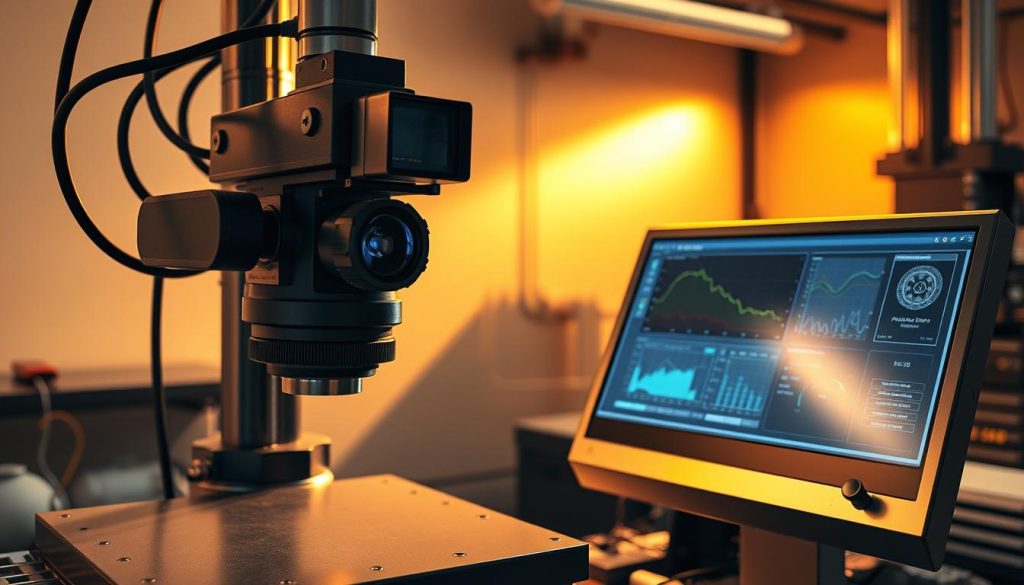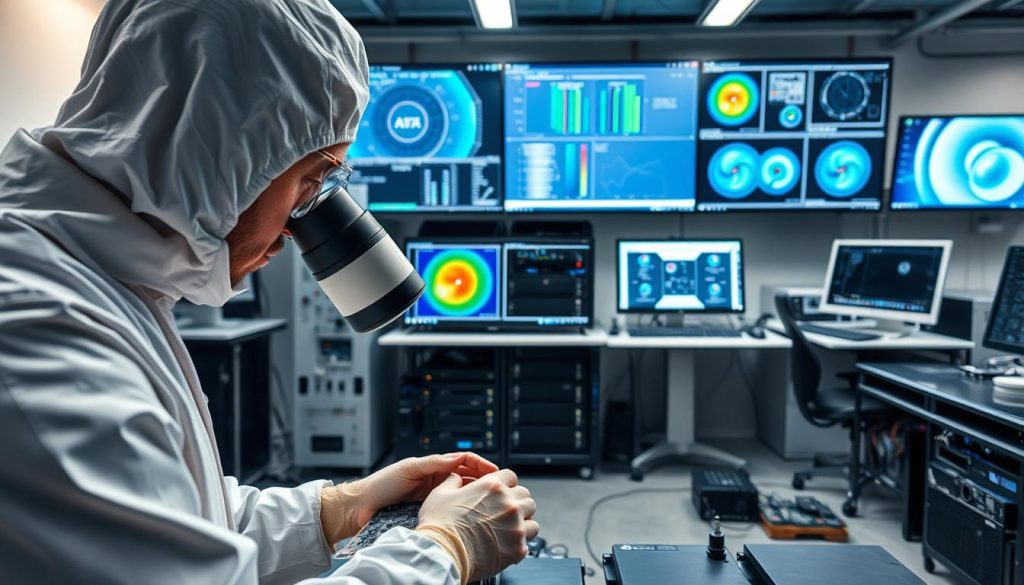Streamline Your Operations with Advanced Visual Inspection Software
August 9, 2025|11:49 AM
Unlock Your Digital Potential
Whether it’s IT operations, cloud migration, or AI-driven innovation – let’s explore how we can support your success.
August 9, 2025|11:49 AM
Whether it’s IT operations, cloud migration, or AI-driven innovation – let’s explore how we can support your success.
Modern businesses face growing pressure to maintain flawless quality standards while optimizing workflows. Traditional manual checks often struggle to keep up with high-speed production lines or complex compliance requirements. This is where automated systems powered by AI and machine learning redefine what’s possible.
By integrating high-resolution cameras with intelligent algorithms, these solutions detect imperfections faster than human teams. They analyze patterns across thousands of units per minute, identifying issues like micro-fractures or alignment errors that might otherwise go unnoticed. The result? Consistent output with fewer delays or recalls.
We’ve designed this guide to help decision-makers evaluate options effectively. Implementation requires aligning technical capabilities with operational goals—whether reducing waste in manufacturing or ensuring safety in pharmaceuticals. The right choice balances scalability, integration ease, and long-term ROI.
Industries are transforming quality assurance by replacing outdated manual methods with intelligent systems. These solutions merge cutting-edge sensors with adaptive algorithms, creating a new standard for precision. By eliminating human error, they deliver uniform results across production cycles while meeting strict compliance demands.
Traditional approaches often struggle with speed and consistency. We’ve seen automated systems process 300% more units per hour than manual teams while maintaining 99.8% accuracy. Advanced algorithms learn from historical patterns, refining their defect detection capabilities over time.
This technology adapts to environmental variables like lighting changes or equipment vibrations. Standardized protocols ensure identical evaluation criteria across shifts, reducing disputes over quality judgments. Operators receive instant alerts when thresholds are breached, enabling swift interventions.
AI-powered analytics identify microscopic flaws invisible to the human eye, from hairline fractures to coating inconsistencies. Real-time data streams help teams prioritize high-risk assets, preventing 92% of potential failures before they escalate.
Digital audit trails automatically document every decision, simplifying regulatory reviews. Managers gain centralized access to performance metrics, fostering data-driven adjustments. This approach reduces rework costs by 40% while accelerating time-to-market for critical products.
Production environments demand tools that adapt as quickly as operational needs evolve. Leading systems now combine flexible frameworks with self-improving algorithms, creating dynamic solutions for modern quality challenges.
We’ve observed how adaptable templates empower teams to standardize evaluations without sacrificing specificity. Operators configure checklists for unique product lines while maintaining uniform criteria across locations. This approach reduces training time by 65% compared to rigid systems.
Neural networks analyze thousands of images daily, identifying patterns humans might overlook. One automotive supplier reduced false positives by 78% after implementing adaptive deep learning models. These systems self-correct when encountering new material variations or surface textures.
Real-time synchronization with production databases enables instant defect classification. When a packaging line detects label misalignments, ERP systems automatically flag affected batches. This closed-loop process cuts response times by 83% compared to manual reporting.
Leading platforms use six-step workflows to correlate defect patterns with root causes. By mapping anomalies to specific machinery or process stages, teams resolve issues before they cascade. The result? Sustainable quality improvements that compound over production cycles.
Navigating the landscape of digital quality assurance solutions demands a methodical approach to vendor assessment. We guide organizations through three critical phases: operational alignment, cost analysis, and capability benchmarking. This structured path ensures investments deliver measurable improvements rather than becoming shelfware.
Transparent pricing structures simplify budgeting but aren’t universal. SafetyCulture’s $24/seat/month model suits small teams, while enterprise-grade solutions from Syntegon or National Instruments require tailored quotes. We recommend mapping must-have features against total ownership costs—including integration expenses and training timelines.
Free tiers help test core functionalities but often lack advanced reporting. One food manufacturer saved $140k annually by switching from a “per-scan” model to fixed subscriptions. Always verify scalability limits before committing.
Capability gaps become apparent during side-by-side product comparisons. While Averroes excels in aerospace-grade precision, EasyODM’s mobile-first design benefits field teams. ScienceSoft bridges legacy systems with modern APIs—critical for pharma companies managing hybrid environments.
We prioritize vendors offering sandbox testing environments. This lets teams validate results against real production data before deployment. Implementation support also matters—56% of failed deployments trace back to inadequate onboarding resources.
Next-generation quality assurance combines intelligent pattern recognition with dynamic learning capabilities. We’ve observed how these systems transform raw data into actionable insights, enabling teams to predict issues before they impact production lines.

Modern solutions automatically compensate for challenging conditions like glare or motion blur. Mitutoyo AI INSPECT processes 5.2MPx images at twice the speed of conventional tools while maintaining 0.01mm precision. This allows detailed analysis of aerospace components and microelectronics without slowing throughput.
Adaptive algorithms learn from diverse training datasets, improving defect detection accuracy with each production cycle. Unlike rigid rule-based systems, they distinguish between harmless variations and critical flaws through statistical pattern analysis.
AI-driven systems slash review time by automating repetitive checks. One automotive client reduced false positives by 78% while doubling line speed. Real-time alerts enable immediate corrections, preventing defective batches from progressing.
Continuous learning ensures these tools adapt to new materials or design changes. The result? Consistent accuracy across shifts without manual recalibration. Our analysis shows such systems prevent 92% of quality escapes that traditional methods miss.
Successful technology adoption hinges on how well new solutions merge with current infrastructure. We prioritize frictionless connections between cutting-edge tools and legacy platforms, ensuring data collection processes enhance rather than disrupt operations. This approach preserves existing investments while unlocking smarter decision-making.
Modern platforms combine automated sensor inputs with manual annotations, creating rich datasets. One automotive client reduced documentation time by 73% using ROO.AI’s real-time dashboards. “The system converts raw numbers into actionable insights before our morning standup,” notes their quality director.
Customizable reports adapt to stakeholder needs—shop floor summaries highlight immediate fixes, while executive briefs track quarterly trends. Mobile access lets field teams submit photos or notes directly into systems, eliminating paper trails. Audit-ready histories auto-generate during each scan.
Role-based permissions ensure engineers, managers, and technicians see relevant data without information overload. Automated tasks route flagged items to appropriate personnel, slashing resolution times by 58% in one case study.
Cross-departmental visibility prevents silos. Maintenance crews receive defect alerts alongside production schedules, while procurement accesses material quality trends. This alignment turns isolated workflows into coordinated quality networks—proving integration isn’t just technical, but cultural.
Leading organizations now achieve operational excellence through intelligent quality systems. We analyze two transformative implementations that demonstrate measurable improvements in accuracy and efficiency.

SafetyCulture’s mobile platform revolutionized paper-based workflows for a global manufacturer. Teams using customizable templates reduced documentation errors by 68% while accelerating equipment checks. Real-time scoring enabled instant corrective actions, cutting resolution times by 41%.
Mitutoyo combined precision instruments with AI-powered analysis in their AI INSPECT solution. The system detects sub-millimeter defects in automotive components with 99.4% accuracy. “Operators master the interface in under two hours,” notes their lead engineer, “while maintaining aerospace-grade standards.”
ROO.AI eliminated paper checklists across 217 facilities through visual-first interfaces. Their approach leverages human processing speed advantages, reducing task times by 79% versus text-based systems. Compliance rates jumped 54% as teams prioritized critical defects through intuitive dashboards.
One pharmaceutical client achieved 98% audit readiness using automated reporting features. These AI-driven quality checks now prevent 12,000 potential errors monthly across their production lines.
As industries accelerate toward smarter production models, quality assurance systems are entering a transformative phase. We expect AI-driven tools to evolve beyond current capabilities, blending deeper learning models with real-time adaptability. This shift will empower teams to address emerging challenges while maintaining rigorous quality benchmarks.
Next-generation neural networks will predict defects before physical manifestations occur. These self-teaching systems analyze historical inspection results and environmental variables, refining their accuracy autonomously. By 2026, we anticipate 70% faster anomaly detection through process smart algorithms that optimize themselves during operations.
Dynamic systems will automatically adjust workflows based on production speed and defect patterns. Imagine video-enabled tools that track assembly lines while suggesting process tweaks. Cross-functional teams will collaborate through unified dashboards, reducing decision latency by 83% in pilot programs we’ve observed.
Our solutions combine deep learning algorithms with high-resolution image analysis to identify subtle anomalies human operators might miss. This approach reduces false positives by 38% on average while maintaining 99.6% detection consistency across production batches.
Yes, we design data-driven workflows that connect seamlessly with ERP platforms like SAP and Oracle. Through API-first architecture, teams can centralize quality metrics, equipment performance data, and compliance documentation without disrupting current operations.
Unlike static templates, our adaptive models learn from every inspection cycle. Machine vision analyzes product variations in real time, while natural language processing converts video observations into actionable reports. This dynamic approach cuts review time by 65% compared to manual methods.
Mitutoyo and ROO.AI clients typically deploy our iOS/Android-compatible platform within 72 hours. Preconfigured templates for common industrial instruments accelerate onboarding, while custom workflows can be added in 2-3 weeks through our low-code interface.
Partners report 47% faster audit completion speeds and 31% reduction in warranty claims within six months. Our analytics dashboard tracks defect patterns across production lines, helping prevent recurring issues that account for 22% of quality costs in manufacturing sectors.
We employ military-grade encryption both in transit and at rest, with optional on-premises deployment. Role-based access controls ensure only authorized personnel view proprietary designs or process parameters, while maintaining full compliance with ITAR and GDPR standards.